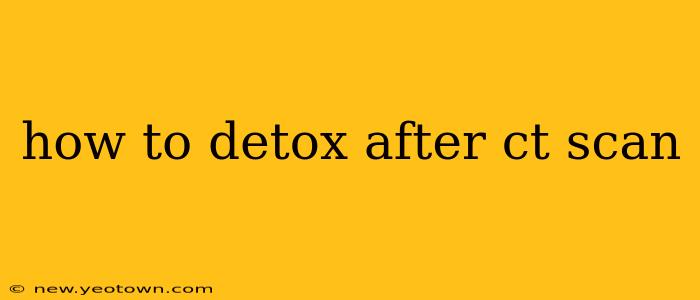The whirring of the CT scanner, the sterile smell of the hospital, the slightly claustrophobic feeling… getting a CT scan is an experience many of us have had, or might have in the future. But afterwards, a common question pops up: how do I detox from the contrast dye? The short answer is, you likely don't need to. Let's unravel the truth behind this post-scan concern.
This isn't to diminish any concerns you might have. Understanding the procedure and what to expect afterwards is crucial for your peace of mind. So let's dive into the details and address some common questions.
What is Contrast Dye, and Why is it Used in CT Scans?
Imagine trying to see the intricate details of a bustling city from far above. You'd need something to highlight the roads, buildings, and important landmarks, right? Contrast dye works similarly in a CT scan. This special iodine-based liquid is injected into your bloodstream, making certain areas of your body – like blood vessels or organs – stand out more clearly on the scan. This allows doctors to get a much more detailed view of your internal structures.
Is Contrast Dye Harmful? Are There Side Effects?
The contrast dye used in CT scans is generally considered safe. However, like any medical procedure, there are potential side effects, albeit rare for most people. Some individuals might experience temporary reactions like:
- Warmth or flushing: This is a common feeling as the dye travels through your body.
- Metallic taste in the mouth: Another relatively common side effect.
- Nausea or vomiting: Less common, but some individuals do report this.
More serious allergic reactions are extremely rare, but it's essential to inform your doctor if you have any history of allergies, especially to iodine or shellfish. The medical professionals administering the CT scan are trained to handle any immediate reactions.
How Long Does it Take for the Contrast Dye to Leave Your Body?
This is one of the most frequently asked questions. The contrast dye is primarily filtered out of your body through your kidneys and eliminated in your urine. The process typically takes a few hours to a day or two. You'll notice that your urine might have a slightly different color during this time; this is normal.
Do I Need to Do Anything Special to Help My Body Eliminate the Dye?
The good news is you generally don't need to perform any special "detox" procedures. Staying well-hydrated is always beneficial, and drinking plenty of water will help your kidneys do their job efficiently. This helps flush out the dye more effectively.
What About Specific "Detox" Drinks or Methods?
While some claim various detox drinks or methods can speed up the dye's removal, there's no scientific evidence to support these claims. These methods are often unnecessary and may even be detrimental to your health. Stick to drinking plenty of water. Your body is remarkably efficient at eliminating the contrast dye on its own.
What if I Have Kidney Problems?
If you have pre-existing kidney problems, it's crucial to discuss this with your doctor before your CT scan. Your doctor might adjust the type and amount of contrast dye used, or even choose an alternative imaging method. This is vital to prevent potential complications.
Should I be Concerned about Long-Term Effects?
Extensive research has shown no evidence of long-term adverse health effects from the contrast dye used in standard CT scans. The amount of dye used is carefully controlled, and the body efficiently processes and eliminates it.
In conclusion, while understanding the potential side effects of contrast dye is important, the need for elaborate "detox" strategies after a CT scan is generally unnecessary. Staying hydrated is sufficient. If you have any concerns, don't hesitate to consult your doctor or the radiologist who performed the scan. They are the best source of information for your specific situation. Remember, peace of mind is crucial for your overall health and well-being.

